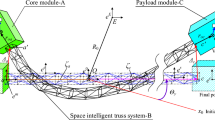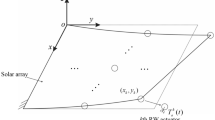Abstract
To deal with the vibration problem of the solar power satellite (SPS), the distributed vibration control approach is investigated in this paper. Taking the Multi-Rotary joints SPS as the research objective, the control unit (CU) and the location relationship matrix are firstly defined for distributed controller design according to the configuration of SPS. The dynamic model of each CU is therefore established based on the finite element method. The dynamic model of the whole SPS structure is then developed using the CU models, and is updated along with on-orbit assembly. The distributed cooperative controller, using proportional and differential feedback and the interaction feedback among adjacent CUs, is proposed to suppress vibration. The close-loop distributed cooperative control system is then achieved by integrating all distributed controllers, and the asymptotic stability is proofed by the Lyapunov’s stability theorem. To verify the feasibility of the proposed control system, three numerical cases are finally presented. The results demonstrate that the distributed cooperative controllers can effectively suppress vibration during on-orbit assembly and operation after assembly, and the closed-loop system has good fault tolerance.
Similar content being viewed by others
Change history
11 February 2022
A Correction to this paper has been published: https://doi.org/10.1007/s42064-022-0136-2
References
Glaser, P. E. Power from the sun: its future. Science, 1968, 162(3856): 857–861.
Glaese, J. R., McDonald, E, J. Space solar power multi-body dynamics and controls, concepts for the integrated symmetrical concentrator configuration. NASA NAS8-00151, NASA Marshall Space Flight Center, 2000.
Mankins, J., Kaya, N., Vasile, M. SPS-Alpha: the first practical solar power satellite via arbitrarily large phased array (A 2011–2012 NIAC Project). In: Proceedings of the 10th International Energy Conversion Engineering Conference, 2012, 1–13.
Yang, Y., Zhang, Y. Q., Duan, B. Y., Wang, D. X., Li, X. A novel design project for space solar power station (SSPS-OMEGA). Acta Astronautica, 2016, 121: 51–58.
Hou, X. B., Wang, L., Zhang, X. H., Zhou, L. Concept design on multi-rotary joints SPS. Journal of Astronautics, 2015, 36(11): 1332–1338.
Seboldt, W., Klimke, M., Leipold, M., Hanowski, N. European sail tower SPS concept. Acta Astronautica, 2001, 48(5–12): 785–792.
Sasaki, S., Tanaka, K., Higuchi, K., Okuizumi, N., Kawasaki, S., Shinohara, N., Senda, K., Ishimura, K. A new concept of solar power satellite: tethered-SPS. Acta Astronautica, 2007, 60(3): 153–165.
Chen, T., Wen, H., Hu, H., Jin, D. P. Output consensus and collision avoidance of a team of flexible spacecraft for on-orbit autonomous assembly. Acta Astronautica, 2016, 121: 271–281.
Donatiello, D., Dipaola, A. Preliminary study on a vibration suppression system for a large flexible space structure. LAVAGNA, MICHÈLE, 2012.
Liu, Y. F., Hou, X. B., Wang, L., Zhou, L. Design of control system for huge flexible structures in space solar power station. Manned Spaceflight, 2017, 23(4): 440–447.
Wei, Y., Deng, Z. C., Li, Q. J., Zhang, K. Analysis of dynamic response of tethered space solar power station. Journal of Astronautics, 2016, 37(9): 1041–1048.
Fujii, H., Watanabe, T., Kojima, H., Sekikawa, K., Kobayashi, N. Control of attitude and vibration of a tethered space solar power satellite. In: Proceedings of the AIAA Guidance, Navigation, and Control Conference and Exhibit, 2003.
Wie, B., Roithmayr, C. M. Attitude and orbit control of a very large geostationary solar power satellite. Journal of Guidance, Control, and Dynamics, 2005, 28(3): 439–451.
Zhou, D., Fan, J. X. Active vibration control of tethered solar power satellite during attitude maneuvering. Journal of Astronautics, 2012, 33(5): 605–611.
Zhou, D., Fan, J. X. Boundary control in the attitude maneuvering of tethered space solar power satellite. Journal of Vibration Engineering, 2013, 26(1): 41–47.
Luo, Y. J., Xu, M. L., Yan, B., Zhang, X. N. PD control for vibration attenuation in hoop truss structure based on a novel piezoelectric bending actuator. Journal of Sound and Vibration, 2015, 339: 11–24.
Hu, Q., Jia, Y. H., Xu, S. J. Adaptive suppression of linear structural vibration using control moment gyroscopes. Journal of Guidance, Control, and Dynamics, 2014, 37(3): 990–996.
Li, D. X. Decentralized vibration control of large flexible structures: theories and methods, 3th ed. Science Press, 2013.
Li, D. X., Xu, R. Autonomous decentralized intelligent vibration control for large split-blanket solar arrays. Science China Technological Sciences, 2013, 56(3): 703–712.
Jiang, J. P., Li, D. X. Optimal placement and decentralized robust vibration control for spacecraft smart solar panel structures. Smart Materials and Structures, 2010, 19(8): 085020.
Ulutas, B., Kerley, D., Dunn, J., Suleman, A., Park, E. J. Distributed H ∞ control of dynamically coupled segmented telescope mirrors: design and simulation. Mechatronics, 2012, 22(1): 121–135.
Ulutas, B., Suleman, A., Park, E. J. LMI-based distributed H ∞ control of dynamically coupled large segmented telescope mirrors. In: Proceedings of the 2014 IEEE/ASME International Conference on Advanced Intelligent Mechatronics, 2014, 297–303.
Ulutas, B., Suleman, A., Park, E. J. LMI-based distributed H ∞ control of the thirty meter telescope’s primary mirror. Mechatronics, 2015, 28: 55–66.
Hu, Q., Su, L., Cao, Y. G., Zhang, J. Decentralized simple adaptive control for large space structures. Journal of Sound and Vibration, 2018, 427: 95–119.
Meng, D. S., Wang, X. Q., Xu, W. F., Liang, B. Space robots with flexible appendages: dynamic modeling, coupling measurement, and vibration suppression. Journal of Sound and Vibration, 2017, 396: 30–50.
Xu, W. F., Meng, D. S., Chen, Y. Q., Qian, H. H., Xu, Y. S. Dynamics modeling and analysis of a flexible-base space robot for capturing large flexible spacecraft. Multibody System Dynamics, 2014, 32(3): 357–401.
Duan, B. Y. The main aspects of the theory and key technologies about space solar power satellite. Scientia Sinica Technologica, 2018, 48(11): 1207–1218.
Wang, L. The general idea and construction scheme of the megawatt solar power experiment satellite. In: Proceedings of the Second Solar Power Satellite Technology Development Seminar, 2017.
Shen, X. F., Zeng, L. B., Jin, Y. Q., Zhang, Q. Z. Status and prospect of on-bit assembly technology. Manned Spaceflight, 2017, 23(2): 228–235, 244.
Cheng, Z. A., Hou, X. B., Zhang, X. H., Zhou, L., Guo, J. F., Song, C. L. In-orbit assembly mission for the space solar power station. Acta Astronautica, 2016, 129: 299–308.
Gorinevsky, D., Hyde, T., Cabuz, C. Distributed localized shape control of gossamer space structures. In: Proceedings of the 19th AIAA Applied Aerodynamics Conference, Fluid Dynamics and Co-located Conferences, 2001, 1–8.
Wang, E. M., Wu, S. N., Song, X. S. et al. Distributed cooperative vibration control for solar power satellite. In: Proceedings of the 4th IAA Conference on Dynamics and Control of Space Systems Conference, 2018.
Duan, G. R. Linear system theory, 2nd ed. Harbin Institute of Technology Press, 2004.
Acknowledgements
This work was supported by the National Natural Science Foundation of China (Grant Nos. 11432010 and 11502040), and the Fundamental Research Funds for the Central Universities of China (Grant No. DUT18GF304).
Author information
Authors and Affiliations
Corresponding author
Additional information
Enmei Wang is now a candidate Ph.D. at Dalian University of Technology in Dalian, China. She obtained her B.S. degree in computer science and technology from Dongbei University of Finance and Economics and joined the School of Aeronautics and Astronautics in Dalian University of Technology in 2013. Her research interests include the dynamics modelling and distributed control of large space structures.
Shunan Wu is now an associate professor at the School of Aeronautics and Astronautics, Dalian University of Technology, China. He received his Ph.D. degree in aerospace science and technology from Harbin Institute of Technology in 2012. His research interests include dynamics and control of large space structure.
Yufei Liu is now a senior engineer at the Qian Xuesen Laboratory of Space Technology, China Academy of Space Technology. He received his Ph.D. degree in deep space exploration dynamics and control from Harbin Institute of Technology in 2007. His research interests include dynamics and control of large space structure, deep space exploration technologies.
Zhigang Wu is now a professor at the State Key Laboratory of Structural Analysis for Industrial Equipment, Dalian University of Technology, China. He received his Ph.D. degree in flight vehicle design from Harbin Institute of Technology, in 1998. Professor Wu’s research interests include dynamics and control of aircraft, numerical method applying on the optimal control and robust control.
Xiangdong Liu is now a professor in the School of Automation, Beijing Institute of Technology, China. He received his Ph.D. degree in flight vehicle design from Harbin Institute of Technology in 1998. Professor Liu’s research interests include nonlinear control, robust control and estimation, servo systems, macro/nano positioning, attitude control, formation flying, and multi-agent systems.
Rights and permissions
About this article
Cite this article
Wang, E., Wu, S., Liu, Y. et al. Distributed vibration control of a large solar power satellite. Astrodyn 3, 189–203 (2019). https://doi.org/10.1007/s42064-018-0046-5
Received:
Accepted:
Published:
Issue Date:
DOI: https://doi.org/10.1007/s42064-018-0046-5




